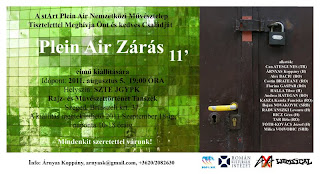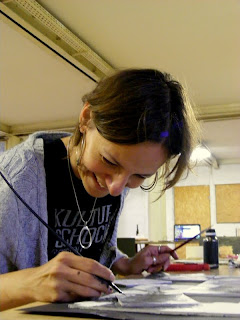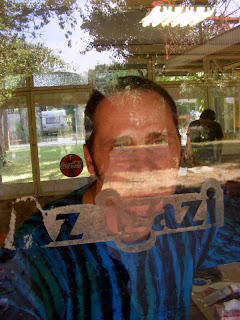Closing Exhibition.

Dear attendees, teachers and students,
The Institute that hosts today’s exhibition always had and has presently excellent teachers and talented students. As a proof of that let me cite from two of them:
Ernő Fischer who had been the Head of Department between 1959-1974, for 11 years, used to say:
„The natural desire of teaching and art has always and in every area has been the desire for
synthesis. To show the harmony between humankind and its’ world, to show the meaning behind this phenomenon, to define the value and quantity of the multitude of things, to show the way from the extracted truth to the truth that is beyond everything that is called law.”
The second thought is from Pál Lázár, who had been a student here from 1959 till 1963, and
from that point until his death he had been a member of the community as a teacher. He used to say:
„Young people always want different things than the old ones. This is completely natural.
However I would like to make them see that painting is a profession, that also has its’
requierements as any other job...”
„You cannot teach art, but you can teach profession. Someone who has something to say and has been prepared to express it, that will be an artist”
I could stop this speech at this point, since these two citations describe what the art workshop
and the exhibition mean to me. The reason why I continued is this: the
actualization and the trin of thought that follow these two thoughts.
During the least 3 weeks, we had several discussions with the participants of the 6th teacher and student assembly and the Start Plein air, about their professional and pedagogic
experiences regarding their studies.
We talked about who is a good teacher and what is a good student like. We expressed numerous conflicting opinions regarding teacher-student relationship.
It was made clear that there is a variety of good teachers.
Besides the transmission of devotion towards profession, and knowledge of art, the good master gives guidelines to help the students to proceed forward in the world. No need to say that the students have to find their way on their own. The good teacher sets you free and provides alternatives, and opportunities for the students on how to get to know themselves and how to build their own artistic world. To be able to do so, frankness and being reasonable are of prominent importance.
And what about the good student?
The good student pays attention to his/her master, does his/her work, and then proceeds how
he/she thinks is right based on what he/she has learnt, and then suprises the teacher with an
outstanding creation.
Ladies and Gentleman!
The eldest exhibitor is 66 years old, the youngest is 22. The difference is
more than just the generation time , professional, theoretical difference just to name a few.
This difference is the main magic of the teacher-student course. The interaction in a relaxed
place. Here the teacher sets the student free, and the student catches a glimpse of
the fights, and professional solutions of his/her master. The manifestation of all this is this
exhibition, that gives us the hope, that many of these students later become highly appreciated
masters themselves. This way this pedagogic work transforms into an initiation rite, which reaches its destination.
Of corse, biesides the work, this 3 weeks are about, the different cultures meeting, about the traditions, relationships, friendships. The taste of kebab, gulas, goat, kuru paszulje pilaf, lókum, pankakes, will evoke Csongrád in the memories of the participants.
Of corse, biesides the work, this 3 weeks are about, the different cultures meeting, about the traditions, relationships, friendships. The taste of kebab, gulas, goat, kuru paszulje pilaf, lókum, pankakes, will evoke Csongrád in the memories of the participants.
The Start Plein air international art workshop is a good exaple of the succsess of the teaching procecc.
The aim of this fee-paying and independent art workshop organized by Koppány Árnyas is to find their own traditions besides the already existing ones. The so-to-say core of the group consists of the participants of the teacher student course held in 2009. They became friend there. They believein the community forming force of art. They think that the inhabitants of Csongrád acknowledge their artistic work and they are friendly. At this exhibition they would like to prove that they have their place amongst the masters, and they are a credit to their teachers.
In my opinion they’ve done an excellent job.
The ever being desire
looking for the law ( said by Ernő Fischer) made me think that the 6th teacher and student assembly is a stop of a process.
To illustrate this let me read out loud some names. The common thing in them is that
To illustrate this let me read out loud some names. The common thing in them is that
they have been the teachers of the teachers at todays’ exhibition. Their humanity, thoughts and view on art can be found by looking at their masterpieces. They more than deserve to be named:
Anto Kuduz....Zelimir Janes.
Do not forget that they also had teachers, and we could go on...
We are the successors and users of the mountains of artistic and human values that have
accumulated throughout the numberless years. Fine artists defend the intactness of the mountain of fine arts and they must replace the golden stones they use. They have to watch out for the exterior effects such as : kitch rivers, hatred winds and ice of greed that threaten this. They must never let this splendid heritance to perish!
This present exhibition shows us the work of this three weeks, the variety of different cultures, traditions.
To get closer to the meaning of eache masterpeace, I’de quote Walter Benjamin:
„ Dear attendees, you have to finde the key.”
At the end, let me cite from Comenius. Bare in mind these words while watching the pictures.:
The image writer writes the picture ( vision) , the painter with his brushes on the slab, hold the little paint making table on his left, ont he supporting, on which the paits have been broken by the valets, on a marbel stone.
The image founder sculpt the still images, of wood and stone. The artificial channeler channels visages images and letters on the copper,wood, and other ores, by chisel.
The picture writings delight our eyes, and adorn our houses.
Congratulation fot the artists and organizers!
László Kecskés


















































